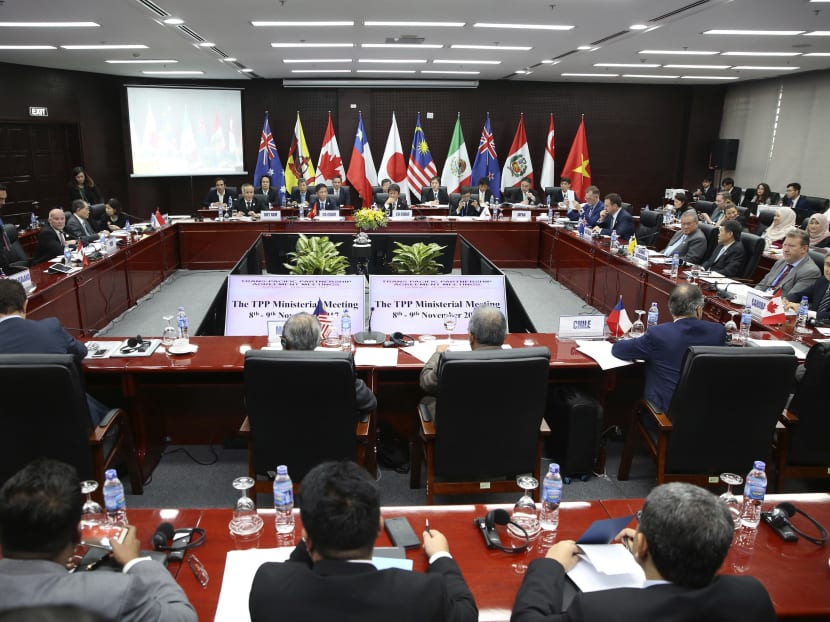Why TPP 11 matters for Singapore
The remaining 11 members of the Trans Pacific Partnership (TPP) have agreed to move ahead on the trade pact without the United States.

Trade ministers and delegates from the members of the Trans-Pacific Partnership meeting in Danang, Vietnam, Nov 9. The new agreement reached by the 11 countries shows that globalisation is alive and well and that comprehensive trade agreements are still possible, says the author. Photo: New York Times
The remaining 11 members of the Trans Pacific Partnership (TPP) have agreed to move ahead on the trade pact without the United States.
The breakthrough on the sidelines of the Asia Pacific Economic Forum in Vietnam came despite an earlier scare that resistance from Canada could mark a death knell for the TPP.
The new pact, called the Comprehensive and Progressive Agreement for the TPP (CPTPP), suspends 20 provisions of the original deal, mostly related to intellectual property.
While the final texts and schedules of CPTPP have not been released yet, previous commitments on goods, services, investment and the like are said to be unchanged.
We can expect leaders to officially sign the final texts and schedules early in 2018. CPTPP will enter into force after at least six countries ratify it. This could be as soon as next year or, potentially, by January 2019.
All this is cause for celebration for Singapore. While the country has been at the forefront of negotiating and signing free trade agreements, few matter more than the TPP.
It is not just the benefits that will flow to Singapore-based firms, or the high standards that the Singapore government has helped promote for trade in the region.
More importantly, CPTPP shows that globalisation is alive and well, and that comprehensive trade agreements are still possible.
For such a trade-dependent nation as Singapore, these are ideas that matter.
Notably, companies will also gain tangible benefits. CPTPP offers access to a market of 500 million people, with a combined GDP of US$10 trillion (SS$13.6 trillion).
Businesses will need to start preparing now because the CPTPP will provide market opportunities that are different from existing agreements.
What makes the pact so relevant is the deep, interlocking nature of the commitments. Unlike other free trade agreements (FTAs), the CPTPP does not simply open up trade in some goods or partially address services or investment. It manages to better reflect the way that firms actually structure business operations today.
It will allow companies to more seamlessly move goods, services, and investments between and across TPP member markets. This benefits not just the biggest firms that have always had advantages of scale, but smaller firms that often struggle to sort out complex rules in trade deals.
The CPTPP does not just provide new market options in Canada and Mexico, where Singapore does not yet have trade deals.
It also provides new opportunities with existing partners, even in Asean member states Malaysia, Vietnam and Brunei, since CPTPP commitments go well beyond what Asean has managed to provide.
Singapore can supply nearly all services and invest in all sectors under CPTPP. This has not been possible yet under the Asean Economic Community, for example, where investors can face equity caps or are required to have joint venture partners.
Service providers in areas like engineering, accounting, consulting, construction and the like do not need a local presence to provide these services in TPP member countries.
Singapore-based firms will also have unprecedented access to Japan, Australia, New Zealand, Chile and Peru.
The key benefit of CPTPP is the extent and depth of tariff cuts. Tariffs act like taxes applied on goods crossing borders.
Higher levels of tariffs can limit trade, and one key goal of free trade agreements is to cut these levels down. Better quality trade agreements have steeper tariff cuts overall in shorter time periods.
The CPTPP is a truly high quality agreement in this regard, especially compared to most alternatives, as it broadly starts with tariff cuts on 90 per cent of all tariff lines on the very first day of the agreement. Many of the tariffs fall all the way to zero on day one and the rest drop to zero mostly within three to five years.
Unlike the market access schedules, which are different for each member country, the rules of origin commitments are the same for all.
Once a product has met the requirements of the CPTPP, it can be shipped without charge into every other member country. CPTPP benefits apply only for goods being shipped into member countries.
Of particular importance to companies, the new deal does allow cumulation across members—this is one of the biggest benefits of using a regional arrangement instead of a bilateral trade deal. Firms can add up, or “cumulate”, the originating content from across all 11 members.
The benefits of CPTPP for businesses are substantial. The agreement will create new market opportunities and result in significant cost savings. This is true even for companies that already have access to preferential trade agreements.
While firms need to plan ahead and think carefully about how to take advantage of the agreement, companies will also need to monitor the implementation of the agreement in TPP11 markets.
The CPTPP is a massive document, but in many cases it remains a guidebook for governments. What also matters is how governments opt to implement the new rules and guidelines at the domestic and local levels.
ABOUT THE AUTHOR:
Deborah Elms is executive director of Asian Trade Centre.






